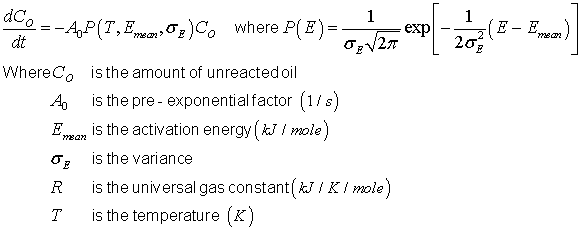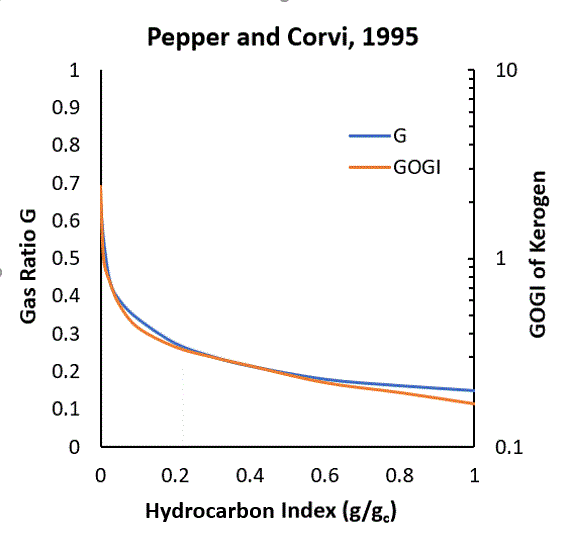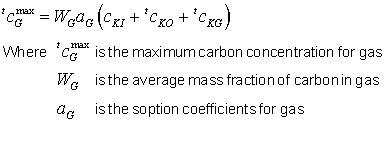Hydrocarbon_kinetics
Data Structure: Hydrocarbon_kinetics |
|
Description |
Defines the assignment and processing data associated with Hydrocarbon kinetic definition |
Usage |
Hydrocarbon_kinetics NUM=ival where ival is the data structure number |
Description |
||||||||||||
Overview This data structure defines the assignment and processing data associated with Hydrocarbon kinetic definition. It is used in conjunction with: •Kerogen_kinetics which defines the data associated with each kerogen type •Group_data - > Kerogen_assignment which assigns Kerogen_kinetics data to specific element groups
The data defined includes: •Vitrinite maturation model and data: currently "EasyRo" is the only model available (Sweeney and Burnham, 1990) •Oil - > Gas cracking data (Pepper and Dodd, 1995) •Hydrocarbon expulsion data Kerogen_gas_sorption and Kerogen_oil_sorption (Pepper and Corvi, 1995(b)) •Hydrocarbon density for porosity update and computation of the rate of volume change for evaluation of pore pressure field
Oil - > Gas cracking (Pepper and Dodd, 1995) Initial oil and generated oil may be transformed to gas. This secondary cracking can be incorporated by using a staggered update procedure where, after updating the kerogen to oil and gas transformation, the oil-gas transformation is evaluated using a similar multicomponent parallel reaction law defined either by a Gaussian distribution ( Oil_gas_cracking_data )
or alternatively by a table of parallel reaction energies ( Oil_gas_cracking_table )
The kinetics of the cracking process, and hence kinetic modelling parameters, are highly dependent on oil composition, primarily the saturate to aromatic ratio of the generated oil. The HI of the source rock, reflecting indirectly the saturate to aromatic ratio of the generated oil, can be correlated with the rate constants for oil cracking, thus allowing prediction of cracking rates based on knowledge of a simple routinely performed geochemical measurement. Consequently an option to use HI dependent parameters is also available.
The type of model to be used is defined via Oil_gas_cracking_model with valid types being: •"Gaussian" - Gaussian distribution defined by the user •"Table" - Table of parallel reaction constants defined by the user •"GaussHI" - Gaussian distribution dependent on the initial hydrocarbon index ( HI0mghc /gc ). For the "GaussHI" model the activation energy and variance are defined by the logarithmic relationships provided by Corvi and Dodd (1995) i.e.
where the default parameters are: •Premultiplier A0 =1014(1/s) •Activation energy constant a1 =233.6(kJ/mol) •Activation energy constant b1 =7.5(kJ/mol) •Variance constant a2 =32.5 •Variance constant b2 =8.55. These parameters may be re-set by defining Oil_gas_cracking_hi_data
Hydrocarbon Expulsion (Pepper and Corvi, 1995(b)) Quantities of oil and gas available, i.e. after the processes of oil and gas generation and oil-gas cracking, are compared with threshold quantities required for expulsion. The oil and gas expulsion threshold (OET and GET, respectively) quantifies the maximum concentration of oil and gas that can be retained relative to the residual organic carbon at that time giving
The change in amount of oil ( cOE) and gas ( cGE) expelled at time t is then defined as
Due to a lack of firm experimental evidence, Pepper and Corvi (1995b) assume global constants: •aG =0.02g/gC •aO =0.10g/gC
Porosity Update due to Kerogen Transformation Geomechanically, the kerogen is contained within the material matrix and defined by the TOC as a weight percentage of the original rock matrix. The total potential porosity associated with the kerogen may therefore be defined as
The volume fraction associated with the kerogen derived from the fractional TOC ( TOCf) as:
The transformation of kerogen to hydrocarbon results in a change in porosity of the source rock equal to the change in volume fraction of kerogen, which is considered part of the matrix. This transformation is assumed to occur when the hydrocarbon is expelled from the kerogen and transferred to the fluid phase so that
Pore Pressure Volume Generation It is assumed that the pore pressure is sufficient that the converted oil and gas are both in a liquid state and that they can be considered as a single hydrocarbon phase with density ρHC. This may either be constant or governed by a simple empirical law as a function of pressure and temperature. After conversion it is initially adsorbed into the Kerogen and both porosity change and pore pressure generation are assumed to occur when the hydrocarbon is expelled from the Kerogen. The rate of volume change is then defined as:
Default hydrocarbon densities for the five kerogen types are shown in the table below:
References •Sweeney. J. J. and Burnham. A. K. (1990), Evaluation of a simple model of vitrinite reflectance based on chemical kinetics. AAPG Bulletin. 74. 1559-1570. •Pepper, A.S. and Corvi, P.J. (1995(a)), Simple kinetic models of petroleum formation. Part I: oil and gas generation from kerogen. Marine and Petroleum Geology. 12(3) 291-319. 1995(a) •Pepper, A.S., Dodd, T.A. (1995), Simple kinetic models of petroleum formation. Part II: oil-gas cracking. Marine and Petroleum Geology. 12(3) 321-340. •Pepper, A.S. and Corvi, P.J. (1995(b)), Simple kinetic models of petroleum formation. Part III: Modelling an open system. Marine and Petroleum Geology. 12(4) 417-452. |
| Oil_gas_cracking_model Defines the Oil -> Gas cracking model |
Usage |
||||
|
||||
Description |
||||
Defines the Oil - > Gas cracking model. Valid values are: • "None" - No Oil - > Gas cracking (default if no oil->gas data specified) • "Gaussian" - Gaussian distribution defined by the user (Default if Oil_gas_cracking_data specified) • "Table" - Table of parallel reaction constants defined by the user (Default if Oil_gas_cracking_table specified) • "GaussHI" - Gaussian distribution dependent on the initial hydrocarbon index ( HI0mghc /gc)
Notes •If "GaussHI" is specified then neither Oil_gas_cracking_data or Oil_gas_cracking_table should be specifed •If "GaussHI" is specified the default constants can be re-defined using Oil_gas_cracking_hi_data
|
| Oil_gas_cracking_premult Defines the Oil -> Gas cracking premultiplier |
Usage |
||||
|
||||
Description |
||||
Defines the Oil - > Gas cracking premultiplier ( A0)
|
| Oil_gas_cracking_data Defines the properties used in Gauss distribution |
Usage |
|||||||||||||||
|
|||||||||||||||
Description |
|||||||||||||||
Oil_gas_cracking_data defines the properties used in Gauss distribution, which comprise: •Location 1 - activation energy ( Emean) •Location 2 - variance ( σ)
|
|||||||||||||||
| Oil_gas_cracking_hi_data Defines the properties used in HI-dependent Gauss distribution |
Usage |
|||||||||||||||
|
|||||||||||||||
Description |
|||||||||||||||
Oil_gas_cracking_hi_data defines the properties used in HI-dependent Gauss distribution, which comprise: •Location 1 - Activation energy constant a1 - Default value 233.6 (kJ/mol) •Location 2 - Activation energy constant b1 - Default value 7.5 (kJ/mol) •Location 3 - Variance constant a2 - Default value 32.5 •Location 4 - Variance constant b2 - Default value 8.55
|
|||||||||||||||
| Oil_gas_cracking_table Oil -> Gas table |
Usage |
|||||||||||||||
|
|||||||||||||||
Description |
|||||||||||||||
Defines oil to gas table. The data is provided as a 2-D table where: •Row 1 - List of cracking oil to gas weights ( CKO(i)) •Row 2 - List activation energy ( Ei)
|
|||||||||||||||
| Kerogen_gas_sorption Gas sorption coefficient aG |
Usage |
||||
|
||||
Description |
||||
Gas sorption coefficient ( aG (i)). Default value = 0.02 g/gC.
|
| Kerogen_oil_sorption Oil sorption coefficient aO |
Usage |
||||
|
||||
Description |
||||
Oil sorption coefficient ( aO (i)). Default value = 0.10 g/gC.
|
| Carbon_fraction_gas The weight fraction of carbon in hydrocarbons in gas |
Usage |
||||
|
||||
Description |
||||
The weight fraction of carbon in hydrocarbons in gas ( WG (i)). Default fraction = 0.85.
|
| Carbon_fraction_oil The weight fraction of carbon in hydrocarbons in oil |
Usage |
||||
|
||||
Description |
||||
The weight fraction of carbon in hydrocarbons in oil ( WO (i)). Default fraction = 0.85.
|
| Hydrocarbon_density_model Hydrocarbon density type |
Usage |
||||
|
||||
Description |
||||
Hydrocarbon_density_model defines the model for evaluation of the density of the expelled hydrocarbon; i.e. the average density of the expelled oil and liquid gas. Valid values are:
• "Constant" - Constant hydrocarbon density
|
| Hydrocarbon_density_properties Density of combined oil and liquid gas |
Usage |
|||||||||||||||
|
|||||||||||||||
Description |
|||||||||||||||
Hydrocarbon_density_properties defines density of expelled combined oil and liquid gas. The properties are dependent on the model type:
Constant • Hydrocarbon density - Constant value for hydrocarbon density
Notes •Default hydrocarbon densities are available for specific named kerogen types:
|
|||||||||||||||
| Oil_gas_reaction_count Oil gas reaction count |
Usage |
||||
|
||||
Description |
||||
Oil_gas_reaction_count defines the number of parallel reactions in the update procedure (Default =11).
|
| Maturation_model Vitrinite maturation model type |
Usage |
||||
|
||||
Description |
||||
Vitrinite maturation model type. Valid models are: • "EasyRo" - EasyRo model by Sweeney and Burnham (1990)
|
| Easy_ro_activation_table Easy_ro activation table |
Usage |
|||||||||||||||
|
|||||||||||||||
Description |
|||||||||||||||
Easy_ro_activation_table defines Easy_ro activation table. Default is 20 reaction table defined by Sweeney and Burnham where: •Row 1 - List of weights (( fi )), Default =20 •Row 2 - List activation energy ( Ei)
|
|||||||||||||||
| Easy_ro_integration_constants Easy_ro integration constants |
Usage |
|||||||||||||||
|
|||||||||||||||
Description |
|||||||||||||||
Easy_ro_integration_constants are a1, a2, b1 and b2. These are default values defined by Sweeney and Burnham.
|
|||||||||||||||
| Easy_ro_update_constants Easy_ro update constants |
Usage |
|||||||||||||||
|
|||||||||||||||
Description |
|||||||||||||||
Easy_ro_update_constants are r1 and r2. These are default values defined by Sweeney and Burnham.
|
|||||||||||||||
| Kerogen_names List of default kerogen names |
Usage |
|||||||||||||||
|
|||||||||||||||
Description |
|||||||||||||||
Kerogen_names defines the list of default kerogen names.
|
|||||||||||||||
| Kerogen_property_table Kerogen property table |
Usage |
|||||||||||||||
|
|||||||||||||||
Description |
|||||||||||||||
Kerogen_property_table defines the default kerogen properties where: •Row 1 - pre-multiplier ( A0) •Row 2 - activation energy ( Emean) •Row 3 - variance ( σ)
|
|||||||||||||||
| Porosity_update_flag Flag for porosity update due to kerogen to hydrocarbon conversion |
Usage |
||||
|
||||
Description |
||||
During the transformation of kerogen to hydrocarbon additional pore space is created. The Porosity_update_flag defines whether this porosity change will be considered. Valid values are: • 0 - No update of porosity from hydrocarbon reactions • 1 - Update porosity accounting for the pore space generated from hydrocarbon reactions (default)
|
| Strength_update_factor Factor for updating formation strength due to porosity change |
Usage |
||||
|
||||
Description |
||||
Flag for updating formation strength due to porosity change. During the transformation of kerogen to hydrocarbon additional pore space is created. Physically this will result in weakening of the rock. This is represented in the model by reducing the pre consolidation pressure proportional to the change in porosity using the plastic hardening curve defined for the material (SR3 and SR4 models only). The Strength_update_factor defines the amount of weakening to be applied where the range of valid values is: •0.0 where no weaking is applied, to •1.0 where full weakening is applied /n The default value is 0.5
|









